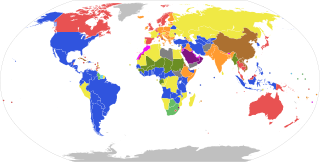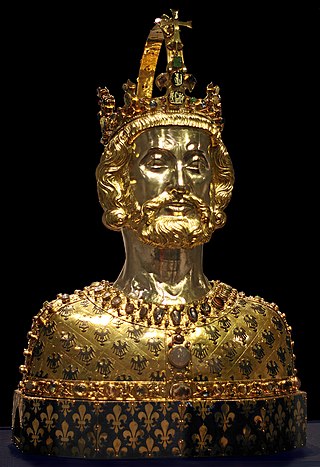
Constitutional monarchy, also known as limited monarchy, parliamentary monarchy or democratic monarchy, is a form of monarchy in which the monarch exercises their authority in accordance with a constitution and is not alone in making decisions. Constitutional monarchies differ from absolute monarchies in that they are bound to exercise powers and authorities within limits prescribed by an established legal framework.

Federalism is a mode of government that combines a general government with regional governments in a single political system, dividing the powers between the two. Johannes Althusius is considered the father of modern federalism along with Montesquieu. Althusius notably exposes the bases of this political philosophy in Politica Methodice Digesta, Atque Exemplis Sacris et Profanis Illustrata (1603). In the Spirit of the Laws, Montesquieu for his part sees examples of federalist republics in corporate societies, the polis bringing together villages, and the cities themselves forming confederations. Federalism in the modern era was first adopted in the unions of states during the Old Swiss Confederacy.
A monarch is a head of state for life or until abdication, and therefore the head of state of a monarchy. A monarch may exercise the highest authority and power in the state, or others may wield that power on behalf of the monarch. Usually a monarch either personally inherits the lawful right to exercise the state's sovereign rights or is selected by an established process from a family or cohort eligible to provide the nation's monarch. Alternatively, an individual may proclaim oneself monarch, which may be backed and legitimated through acclamation, right of conquest or a combination of means.
A monarchy is a form of government in which a person, the monarch, is head of state for life or until abdication. The political legitimacy and authority of the monarch may vary from restricted and largely symbolic, to fully autocratic, and can span across executive, legislative, and judicial domains.
A governor is an administrative leader and head of a polity or political region, ranking under the head of state and in some cases, such as governors-general, as the head of a state's official representative. Depending on the type of political region or polity, a governor may be either appointed or elected, and the governor's powers can vary significantly, depending on the public laws in place locally. The adjective pertaining to a governor is gubernatorial, from the Latin root gubernare.

A grand duchy is a country or territory whose official head of state or ruler is a monarch bearing the title of grand duke or grand duchess.

A federation is a political entity characterized by a union of partially self-governing provinces, states, or other regions under a federal government (federalism). In a federation, the self-governing status of the component states, as well as the division of power between them and the central government, is constitutionally entrenched and may not be altered by a unilateral decision, neither by the component states nor the federal political body.
The abolition of monarchy is a legislative or revolutionary movement to abolish monarchical elements in government, usually hereditary.

A dynasty is a sequence of rulers from the same family, usually in the context of a monarchical system, but sometimes also appearing in republics. A dynasty may also be referred to as a "house", "family" or "clan", among others.

A crown prince or hereditary prince is the heir apparent to the throne in a royal or imperial monarchy. The female form of the title is crown princess, which may refer either to an heiress apparent or, especially in earlier times, to the wife of the person styled crown prince.
An elective monarchy is a monarchy ruled by a monarch who is elected, in contrast to a hereditary monarchy in which the office is automatically passed down as a family inheritance. The manner of election, the nature of candidate qualifications, and the electors vary from case to case. Historically, it was common for elective monarchies to transform into hereditary ones over time or for hereditary ones to acquire at least occasional elective aspects.
A personal union is a combination of two or more monarchical states that have the same monarch while their boundaries, laws, and interests remain distinct. A real union, by contrast, involves the constituent states being to some extent interlinked, such as by sharing some limited governmental institutions. Unlike a personal union, in a federation or a unitary state, a central (federal) government spanning all member states exists, with the degree of self-governance distinguishing the two. The ruler in a personal union does not need to be a hereditary monarch.
Traditional rank amongst European imperiality, royalty, peers, and nobility is rooted in Late Antiquity and the Middle Ages. Although they vary over time and among geographic regions, the following is a reasonably comprehensive list that provides information on both general ranks and specific differences. Distinction should be made between reigning families and the nobility – the latter being a social class subject to and created by the former.
A political union is a type of political entity which is composed of, or created from, smaller polities, or the process which achieves this. These smaller polities are usually called federated states and federal territories in a federal government; and prefectures, regions, or provinces in the case of a centralised government. This form of government may be created through voluntary and mutual cession and is described as unionism by its constituent members and proponents. In other cases, it may arise from political unification, characterised by coercion and conquest. The unification of separate states which, in the past, had together constituted a single entity is known as reunification. Unlike a personal union or real union, the individual constituent entities may have devolution of powers but are subordinate to a central government or coordinated in some sort of organization. In a federalised system, the constituent entities usually have internal autonomy, for example in the setup of police departments, and share power with the federal government, for whom external sovereignty, military forces, and foreign affairs are usually reserved. The union is recognised internationally as a single political entity. A political union may also be called a legislative union or state union.

The German Empire consisted of 25 constituent states and an imperial territory, the largest of which was Prussia. These states, or Staaten each had votes in the Bundesrat, which gave them representation at a federal level.
A non-sovereign monarchy, subnational monarchy or constituent monarchy is one in which the head of the monarchical polity, and the polity itself, are subject to a temporal authority higher than their own. The constituent states of the German Empire or the princely states of the Indian Empire during British rule provide historical examples; while the Zulu king, whose power derives from the Constitution of South Africa, is a contemporary one.

The Monarchy of Germany was the system of government in which a hereditary monarch was the sovereign of the German Empire from 1871 to 1918.

King is the title given to a male monarch in a variety of contexts. A king is an absolute monarch if he holds the powers of government without control, or the entire sovereignty over a nation; he is a limited monarch if his power is restrained by fixed laws; and he is an absolute, when he holds the whole legislative, judicial, and executive power, or when the legislative or judicial powers, or both, are vested in other people by the king. Kings are hereditary sovereigns when they hold the powers of government by right of birth or inheritance, and elective when raised to the throne by choice.








